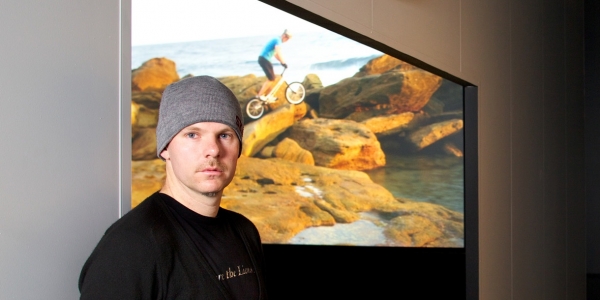For one, that other illusory, UNSW College Of Fine Arts-educated, Venice Biennale-lauded figure probably wouldn’t be caught dead schlepping about in well-worn high-top kicks. And he certainly wouldn’t drop skater-dude slang like “bro” and “awesome” and “badass” when discussing the significant influence of the Baroque portraitist Deigo Velázquez on his work.
As we chat over coffee and tea, I soon realise how “obsessed” is a word never far from the artist’s lips. “I’m obsessed with cinema,” he professes one minute, only to pronounce, “I’m obsessed with the Western history of vanitas,” the next. (Vanitas, by the by, is a gloriously morbid strain of 16th-17th Century European art preoccupied with life’s transience and our state of perpetual decay – skulls and rotting produce abound). I get the sense that his passion is so consuming, he’s actually yet to realise that, frankly, he’s kind of a big deal nowadays.
Stereo Sequences is the first in an intrepid cycle of commissions by ACMI. This new, ongoing initiative, officially dubbed Horizons: The ACMI Commissions Series, will contract contemporary artists—emerging, established, Australian and international alike—to create innovative new works for public display in the high-profile surrounds of the ACMI galleries.
“It was a chance for me to use ACMI and their resources to just experiment,” enthuses Gladwell, “which was maybe a big ask [on my part]. They’ve really had to change gears from the last few shows here!” And change gears they have. Previously occupying ACMI’s subterranean Gallery 1 where Stereo Sequences now resides were the blockbuster exhibitions Tim Burton and Dreams Come True: The Art of Disney Fairytales.
The first new work attendees encounter in the newly de-cluttered gallery is the eight-channel HD video gauntlet Parallel Forces. Four screens line the left wall of the gallery; four line the right. Looped onto them are a series of four two-camera dyads – that is, pieces shot with a pair of cameras, each filming the other, which are then simultaneously projected onto parallel screens to create the finished work. Moving through the space, the spectator finds themselves suspended in the eerie, intangible distance between various cameras. Noisily flanking them, along with Gladwell and his various co-videographers, are a huge pair of EC120 Eurocopters, two black sedans, modelled on the Interceptor out of Mad Max, twin black motorbikes, and finally, a couple of skateboarders surfing an inner-city travelator.
“It looks like some pretty loose, messy, punk-ass video. But it’s pretty considered,” Gladwell says of the footage he both captured and devised for the show. “Even if it’s not seen as methodical ’cause it’s just raw and shaky, there is logic behind it.”
The other showstopper, thoughtfully situated at the exhibition’s end, is a reworking of a piece originally debuted at the 2009 Venice Biennale. In Endoscopic Vanitas, two endoscopic cameras leisurely traverse the weird, hallowed topography both inside and around the outer surface of a real human skull. The camera feeds are projected in real-time onto a pair of screens, the first an apparitional curtain of mist which visitors must breach in order to gain entry to the sanctum (an aptly ethereal touch, that); the second a traditional LCD screen mounted on the wall of the room.
“In culture, I love my skulls,” Gladwell explains. “Death reckoning, memento mori, tempus fugit – bring it on. But I don’t feel like I get enough focus on [their] interior, because the exterior is such a powerful image.”
That’s all part of Gladwell’s story: finding art in the consideration of the taken-for-granted, even the banal. Theoretically, he stresses, anyone could create the works on show in Stereo Sequences. That’s part of what separates a conceptual artist from a purely technical artisan. The only real status distinction between Gladwell and your garden variety skate punk with a consumer-grade DV camera is that he’s now an anyone who can gain legal access to a real human skull.







